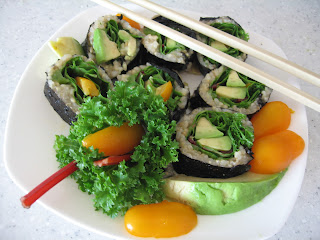Anti-inflammatory Kimbap (almost raw)
1 sheet unoiled, unsalted seaweed laver
1/2 cup sticky brown rice, cooked
2 teaspoons lemon juice
2 teaspoons olive oil
1 clove garlic, minced
sea salt
1-2 mustard leaves
1-2 kales leaves
1/4 ripe avocado
2-3 cherry tomatoes
1 thin strip cucumber
Mix the cooked brown rice with the lemon juice, olive oil, minced garlic and a little sea salt. Then spread the mixture out on a sheet of seaweed laver. The oiled and salted seaweed laver of course tastes better BUT it has been oiled with corn oil (inflammatory) and salted with processed salts which likely include MSG and certainly contains chemicals from the processing. The unoiled, unsalted laver isn't as tasty but the good side is that it doesn't tear as easily when spreading the moist rice mixture AND my eyes won't burn afterwards as a reaction. Also when spreading the mixture, leave a 3/4-inch strip of laver free of rice. After rolling the laver roll this strip will adhere to the roll, making the roll retain its own shape.
After the rice has been spread out thinly and evenly, pile the vegies on the lower area of the riced section. Don't pile it too high or the roll will be too fat to role and will tear.
Next, role the vegies tightly to make a roll. A little moisture could be added if necessary to the strip of exposed laver at the end to make it seal.
With a very sharp, serrated knife, cut the laver roll into 1/2 - 3/4" rounds and lay them on a plate. Serve with a little extra garnish - tomato, wedge of avocado or even on a decorative bed of greens.
Unfortunately, because I have to watch my carb intake in order not to feed the evil bacteria in my system too much and gradually "starve" it, I can't eat more than one kimbap roll at a time. That's a bummer because they taste so good!




No comments:
Post a Comment